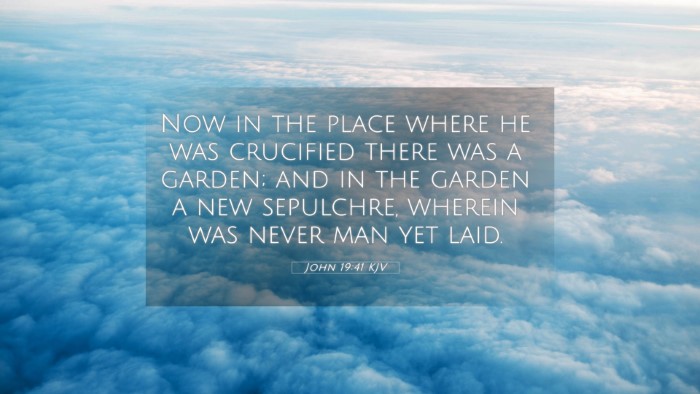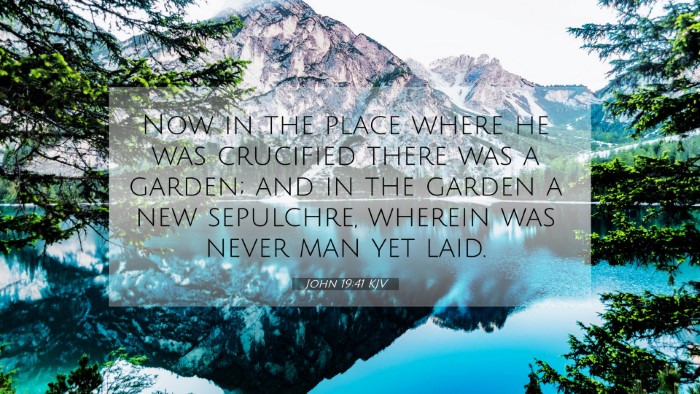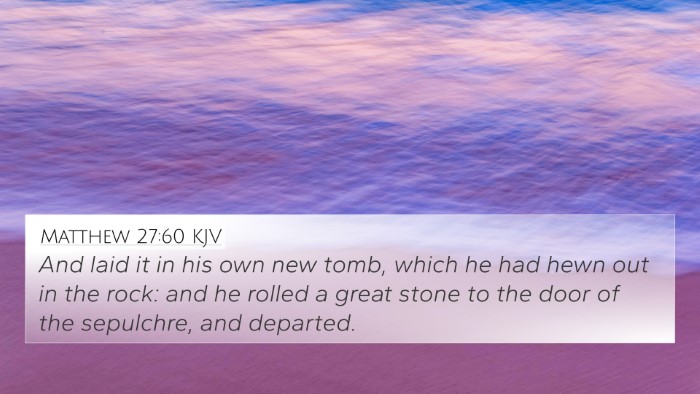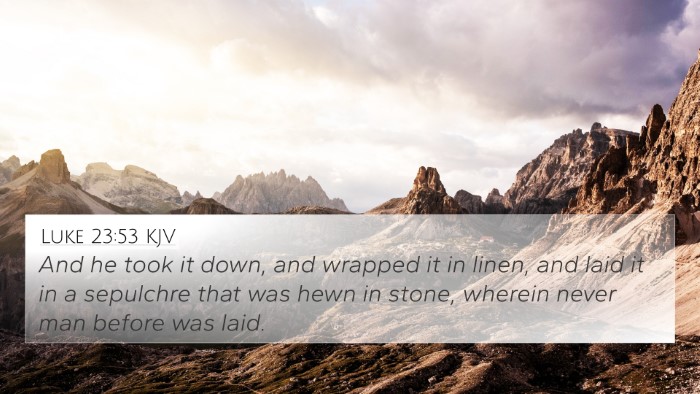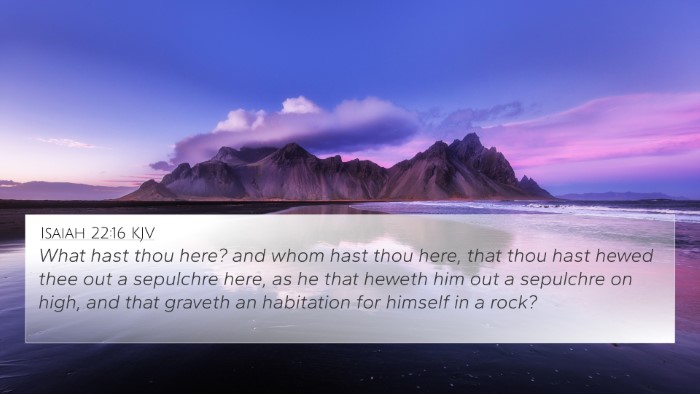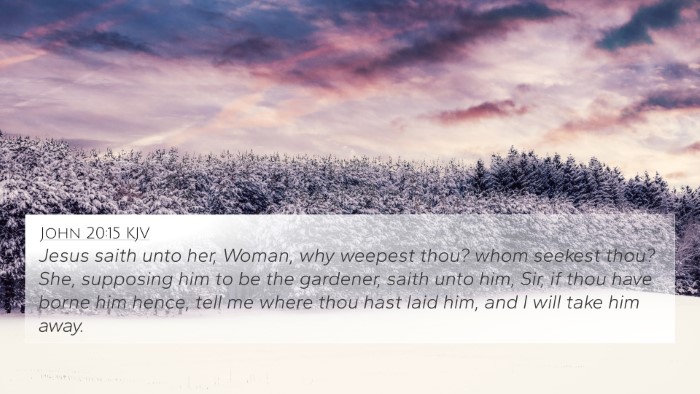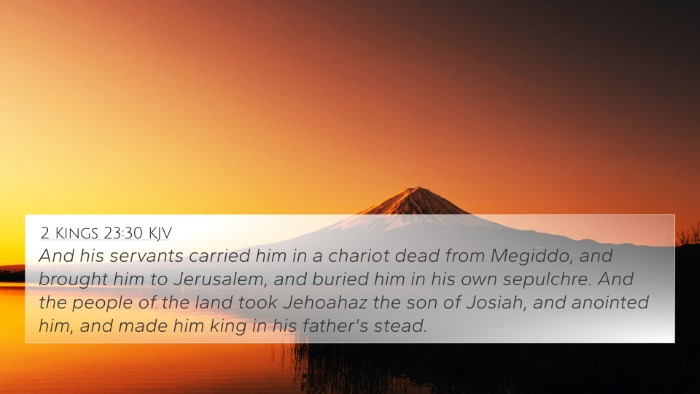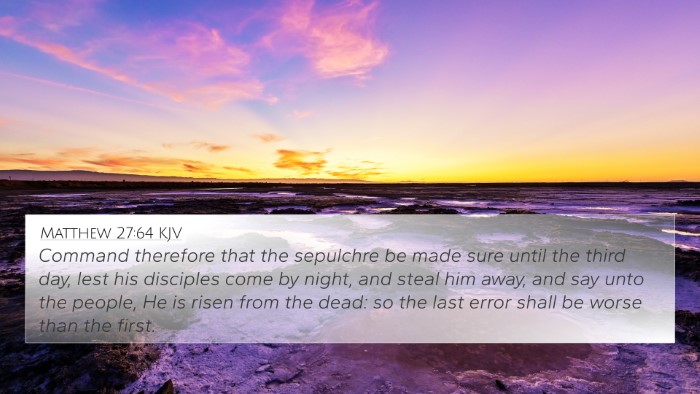Understanding John 19:41
In John 19:41, the verse states: "Now in the place where He was crucified there was a garden, and in the garden a new tomb, in which no one had yet been laid." This verse is imbued with rich theological significance, particularly in its context of Christ's death and resurrection. Below is a detailed analysis rooted in public domain commentaries.
Contextual Overview
This verse appears after the crucifixion of Jesus and details the location of His burial. It specifically mentions the presence of a garden and a new tomb, which are significant for a few reasons discussed in various biblical commentaries.
Theological Significance
- Matthew Henry's Commentary: Henry elucidates that the garden symbolizes new life and resurrection. Just as Adam was formed in a garden, Jesus' resurrection signifies the restoration of life and hope.
- Albert Barnes' Notes: Barnes points out that Jesus' body being laid in a new tomb fulfills prophecy and further signifies His purity, as no one else had been buried there.
- Adam Clarke's Commentary: Clarke notes that the mention of the garden provides a contrast with the sorrow of the crucifixion, symbolizing hope and renewal, a thematic connection to Jesus as the last Adam.
Key Themes in John 19:41
This verse encapsulates several important themes tied to the nature of Christ’s ministry and His role in salvation history:
- Redemption: The burial in a new tomb represents the fulfillment of the redemption plan.
- Fulfillment of Prophecy: The details surrounding Jesus' burial connect to Old Testament prophecies, confirming His messianic role.
- Hope of Resurrection: The garden setting foreshadows the glorious resurrection that follows.
Bible Verse Cross-References
John 19:41 can be cross-referenced with several key scripture passages that enhance its understanding:
- Isaiah 53:9: "And they made His grave with the wicked, but with the rich at His death." This prophecy foretold the manner of Jesus' burial.
- Matthew 27:57-60: This passage describes Joseph of Arimathea's role in providing the new tomb.
- Luke 23:50-53: Explains further details about Jesus’ burial and the significance of the tomb.
- Genesis 3:19: "For you are dust, and to dust you shall return." This connects to the human condition that Jesus addresses.
- 1 Corinthians 15:54-57: Discusses the victory over death, which is a direct result of Christ's resurrection.
- Romans 6:4: "We were therefore buried with Him through baptism into death..." emphasizes the symbolism of burial.
- Revelation 1:18: "I am He who lives, and was dead, and behold, I am alive forevermore..." confirms Jesus’ resurrection.
Connections Between Bible Verses
The connections between John 19:41 and other scriptures exhibit a tapestry woven with themes of death, resurrection, and hope. Through Bible verse cross-references, we can explore:
- The nature of Christ’s sacrifice: Cross-referencing can reveal deeper insights into the purpose of His crucifixion and burial.
- Messianic fulfillments: By comparing this verse with Old Testament prophecies, one can grasp how Jesus’ burial was divinely orchestrated.
- Theological implications of the resurrection: Linking this verse with resurrection passages shines light on the hope found in Christ.
Comparative Bible Verse Analysis
In performing a comparative Bible verse analysis, one may note the following:
- View Jesus in the context of the eternal covenant as depicted in Hebrews 9:12-14.
- Explore the implications of a new tomb with references to John 20:1, describing the empty tomb post-resurrection.
- Investigate the literary parallels between Exodus 12:6 and the timing of Jesus' death and burial.
Tools for Bible Cross-Referencing
For those interested in exploring tools for Bible cross-referencing, consider utilizing:
- Bible Concordances: Useful for finding themes, occurrences, and parallels.
- Bible Cross-reference Guides: These resources can systematically assist in uncovering scriptural connections.
- Bible Study Programs: Software that includes cross-reference capabilities aids in deeper study.
Conclusion
John 19:41 serves as a pivotal moment within the narrative of Jesus’ death and resurrection. Its connections to various scriptures enrich our understanding of the profound mysteries of the faith. Through cross-referencing Biblical texts and recognizing thematic Bible verse connections, believers can better grasp the depths of God’s plan of salvation. The verse encapsulates the hope found in Christ, a theme resonant throughout both the Old and New Testaments.

